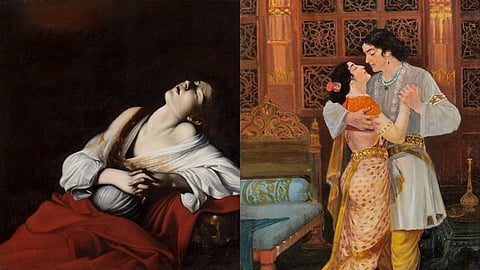
- HOMEGROWN WORLD
- #HGCREATORS
- #HGEXPLORE
- #HGVOICES
- #HGSHOP
- CAREERS
- ABOUT US
- CONTACT US

'Mary Magdalene in Ecstasy', long considered lost and rediscovered in 2014, is attributed to Michelangelo Merisi da Caravaggio — a defining figure of the Baroque movement. Displayed alongside early 20th-century works by Indian painter M.V. Dhurandhar, a new exhibition at the Dr. Bhau Daji Lad Museum in Mumbai reveals how devotion takes shape across cultures: as a struggle between sin and salvation in Caravaggio, and as destiny fulfilled through love in Dhurandhar. Here, passion becomes a pathway to transcendence.
A pale woman is seated against a dark background, arching backwards with her head hanging loosely back and a single tear streaming down from her nearly closed eyes. Her elbow rests on a faintly visible skull. Light and shadow play across her white and red robes, ears, and hands—demonstrating the artist’s masterful command of chiaroscuro, or the treatment of light and shadow in paintings and drawings.
This artwork, titled ‘Mary Magdalene in Ecstasy’, once thought lost, was rediscovered in 2014 and attributed to Michelangelo Merisi da Caravaggio (1571–1610), an Italian painter whose innovations inspired the Baroque movement. It is also the first significant work by the artist to be shown in India. After exhibitions in Delhi and Bangalore, the painting is on view at the Dr. Bhau Daji Lad Museum in Mumbai until November 2, 2025.
The exhibition, titled L’invenzione della luce (The invention of light), curated by Andrea Anastasio and Tasneem Zakaria Mehta, presents the Caravaggio in conjunction with early 20th-century artworks by Indian artist Rao Bahadur Mahadev Vishwanath Dhurandhar, depicting a story from Hindu mythology. It conveys emotional love as a metaphor for spiritual love, much as in Caravaggio’s ‘Mary Magdalene in Ecstasy’.
Though separated by centuries and geography, both artists explore themes of devotion and transcendence. In an interview with The Indian Express, Tasneem Zakaria Mehta—co-curator of the exhibition and director of the Dr. Bhau Daji Lad Museum—said, “the exhibition offers visitors a rare opportunity to witness two artistic worlds converge. Both artists explore devotion — Caravaggio through Mary Magdalene’s divine surrender, and Dhurandhar through Usha’s love for Aniruddha from Hindu mythology. In both, sensual love becomes a metaphor for the spiritual.”
Presenting these artists together collapses the assumed distance between an “European master” and an “Indian academic painter”, revealing a striking thematic continuum: bodies as vessels of revelation, love as a conduit to the divine, and light itself as a form of meaning-making. But it also exposes contradictions: Caravaggio’s Baroque drama emerges from violent post-Renaissance upheaval within the Catholic Church, while Dhurandhar’s works come from a society negotiating colonialism, modernity, nationalism, and the politics of myth.
What happens when these worlds converge?
We see devotion not only as a universal constant, but as a culturally shaped experience — capable of being erotic, defiant, or redemptive depending on where one stands. The exhibition ultimately suggests that transcendence is not a single story told correctly, but a chorus of human attempts to reach beyond ourselves, each illuminated by its own kind of light.
L’invenzione della luce (The invention of light), Caravaggio’s ‘Magdalene in Ecstasy’, in conjunction with Rao Bahadur Dhurandhar’s works, curated by Andrea Anastasio and Tasneem Zakaria Mehta, is on view at the Kamalnayan Bajaj Special Exhibitions Gallery, Dr. Bhau Daji Lad Museum until November 2, 2025. Learn more about the exhibition here.
